

Co-creation. Social media Strategy. Social Media is About Sociology Not Technology. InShare41 The future of engagement introduces sociology into the marketing strategy.
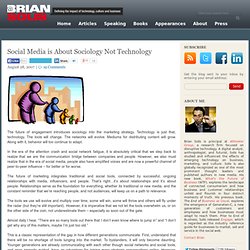
Technology is just that, technology. The tools will change. The networks will evolve. Mediums for distributing content will grow. In the era of the attention crash and social network fatigue, it is absolutely critical that we step back to realize that we are the communication bridge between companies and people. The future of marketing integrates traditional and social tools, connected by successful, ongoing relationships with media, influencers, and people. The tools we use will evolve and multiply over time; some will win, some will thrive and others will fly under the radar (but they’re still important). Almost daily I hear, “There are so many tools out there that I don’t even know where to jump in” and “I don’t get why any of this matters, maybe I’m just too old.” This is a classic representation of the gap in how different generations communicate.
Why? OK, so you decide to jump in. Tags: Influencers & Community Marketing. Why social media projects fail – a European perspective. Campagne social media marketing.
Le vide poches : le blog du planning stratégique 2.0 de PSST (opinions et tendances 2.0) by jérémy dumont: Le buzz marketing serait-il déjà dépassé ? Oui, à en croire Vincent Balusseau, Directeur général du groupe Première Heure, qui dévoile ici le concep. E-Reputation. 9edb20f14419d3076ea9e427ecdd945211f03b5f (Image JPEG, 500x325 pixels) Why and How Influence Works (my SxSW Interactive PanelPicker) What would happen if I told you I could get you hired some place where you'd love to work?
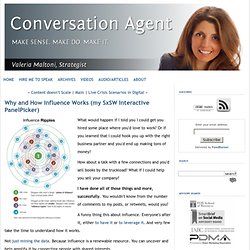
Or if you learned that I could hook you up with the right business partner and you'd end up making tons of money? How about a talk with a few connections and you'd sell books by the truckload? What if I could help you sell your company? I have done all of those things and more, successfully. You wouldn't know from the number of comments to my posts, or retweets, would you? A funny thing this about influence. Not just mining the data. Are appearances making us lazy? The truth is -- everyone is wrong about influence. 5 Ways to Get the Support of Social Media Influencers. It’s the Holy Grail of interactive marketing: getting “social media influencers”—the ones with the voice and the reach, the ones to whom everyone else listens—to endorse and promote what you’re doing. Recently, my company managed to inspire 60 such influencers to participate in our event, called The Influencer Project , and they even took it upon themselves to help spread the word. People like Social Media Examiner’s own Michael Stelzner, Guy Kawasaki, Robert Scoble, Gary Vaynerchuk, David Meerman Scott, and others all signed on.
Identifying Influencers and Measuring Influence. This is another weekly tip in our social media tips series.
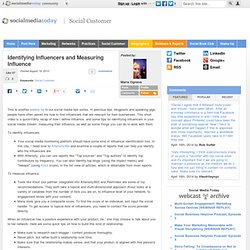
In previous tips, blogposts and speaking gigs, people have often asked me how to find influencers that are relevant for their businesses. This short video is a quick'n'dirty recap of how I define influence, and some tips on identifying influencers in your social media stream, measuring their influence, as well as some things you can do to work with them. To identify influencers: Your social media monitoring platform should have some kind of influencer identification tool. In this clip, I head over to Attensity360 and examine a couple of reports that can help you identify who the influencers are. To measure influence: Tools like Klout (our partner; integrated into Attensity360) and PeerIndex are some of my recommendations. Tipologie e livelli di social influence. A febbraio Augie Ray di Forrester ha pubblicato un report molto interessante: ha introdotto una classificazione degli influencer sulla base dei loro livelli di influenza.
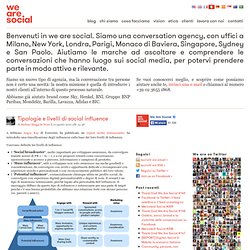
Forrester chiffre l'influence des médias sociaux. Dans une étude intitulée « Peer Influence Analysis », Forrester cherche à mieux cerner les mécanismes d’influence et de bouche à oreille sur le web.
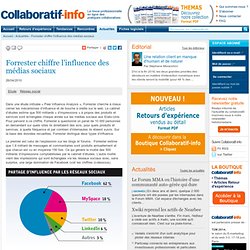
Le cabinet d’études estime que 500 milliards « d’impressions » à propos des produits et services sont échangées chaque année sur les médias sociaux aux Etats-Unis. Pour parvenir à ce chiffre, Forrester a questionné un panel de 10 000 personnes en demandant sur quels sites ils émettaient des avis, pour quels produits et services, à quelle fréquence et par combien d’internautes ils étaient suivis. Sur la base des données recueillies, Forrester distingue deux types d’influence.
Le premier est celui de l’expression sur les blogs et forums. Forrester estime que 1,6 milliard de messages et commentaires sont produits annuellement et que chacun est vu en moyenne 150 fois. What Makes Social Media Trustworthy? One thing that makes social media marketing powerful is consumers’ trust in “people like them”—their friends, family and other online peers.
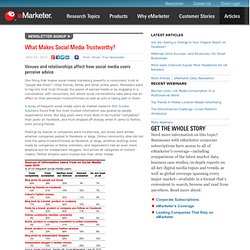
Marketers want to tap into that trust through the power of earned media or by engaging in a conversation with consumers, but where social conversations take place has an effect on their perceived trustworthiness as well as who is taking part in them. A study of frequent social media users by market research firm Invoke Solutions found that the most trusted information was posted by people respondents knew. But blog posts were more likely to be trusted “completely” than posts on Facebook, and trust dropped off sharply when it came to Twitter, even among friends.
Postings by brands or companies were trusted less, but levels were similar whether companies posted to Facebook or blogs. Some other seeming signs of authenticity mattered less to users, however, including length of participation and number of participants.